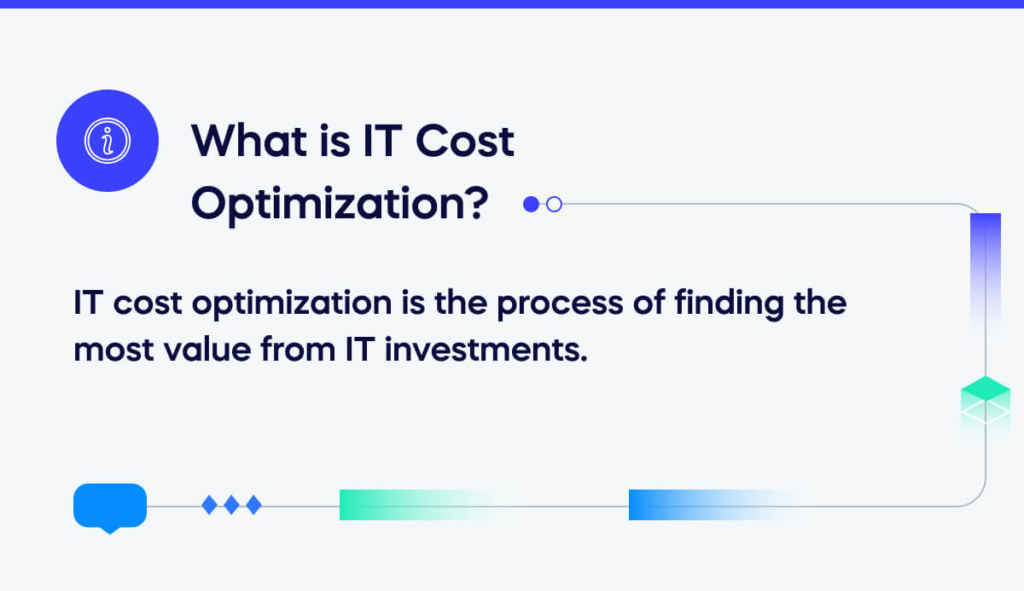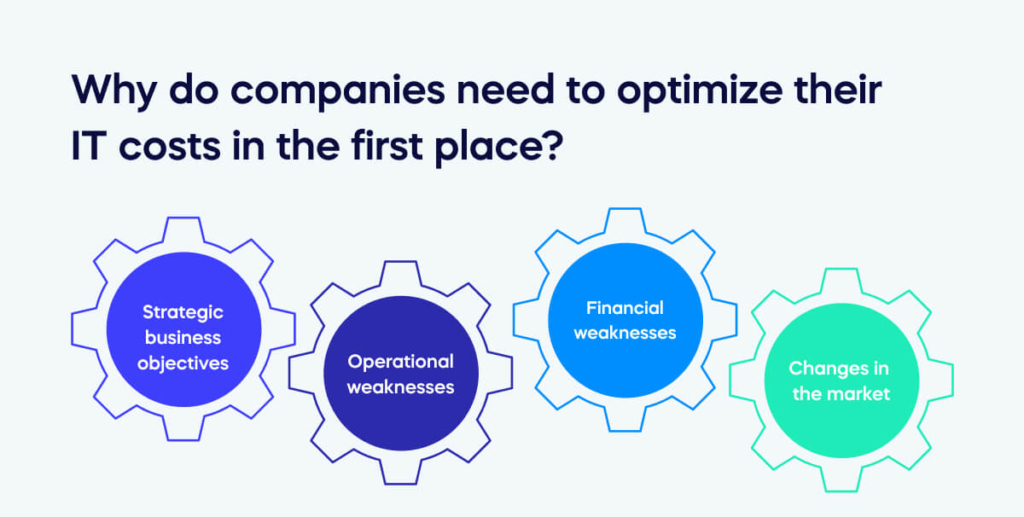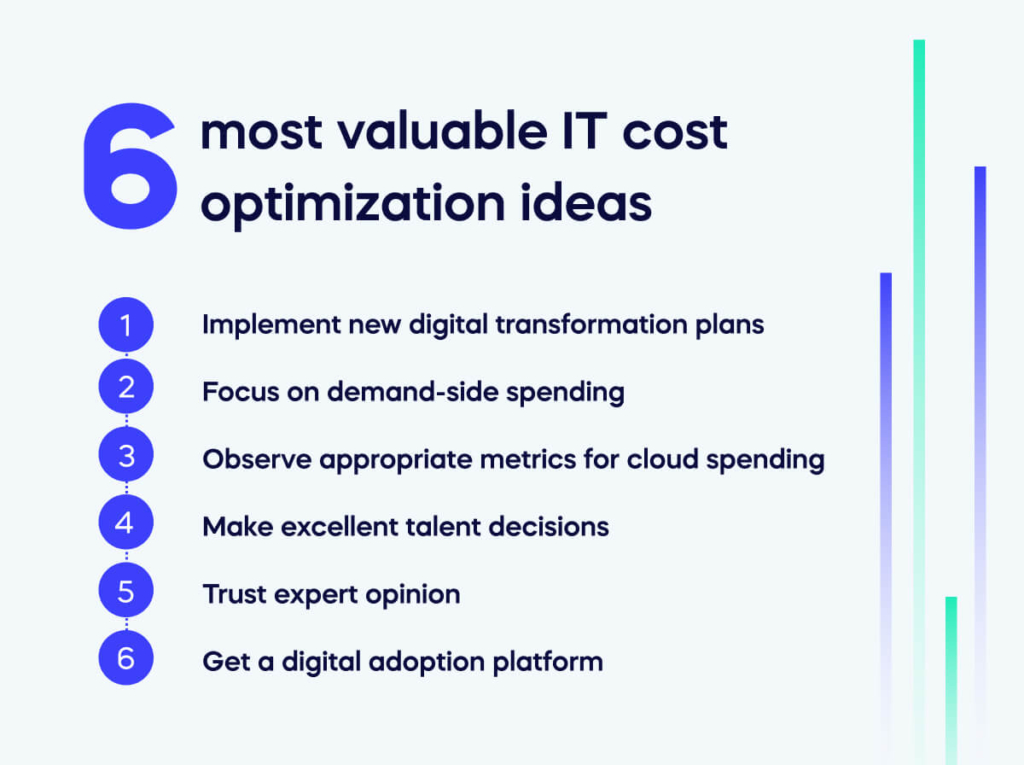Cost optimization is the strategic practice of identifying and implementing measures to reduce operational expenses while maintaining or improving business performance.
2023 has been a big year for IT cost optimization. In the spring, companies planned to cut their IT costs by 7%. And as we move towards the end of the year, the world’s economic problems are worsening.
For many companies, IT costs are a great area for optimization. With its licenses, hidden features, and out-of-the-way errors, many companies can keep the same level of IT provision while making IT cost savings or improving IT systems without increasing costs.
But how do you get started?
We’ve got you covered. This article explores some of the most interesting aspects of IT cost optimization today. We’ll take you through a short definition of IT cost optimization and then describe six great ideas to help you get the best business value out of your IT investments.
Can your IT cost optimization dreams become a reality? We don’t know! But in this article, you’ll start to learn the things you need to know.
What is IT Cost Optimization?

IT cost optimization is the process of finding the most value from IT investments.
It can apply to many aspects of IT management, including procurement, rationalization, business process management, recruitment, and training. IT cost optimization is a dynamic and ongoing process that demands a strategic focus on investments while eliminating unnecessary expenses and maximizing the value derived from IT resources. By addressing various aspects of IT management, organizations can enhance their competitiveness, agility, and profitability in an ever-evolving digital landscape.

Why do companies need to optimize their IT costs in the first place? It’s often a mix of factors. As KPMG’s 2021 Cost Optimization playbook suggests, companies seek cost optimizations for many reasons: strategic business objectives, operational weaknesses, financial weaknesses, or changes in the market. It’s also possible to have a combination of all of these factors.
But at the end of the day, cost optimization is simply good business. Unless your IT operation is working at 100% efficiency, IT cost optimization is worthwhile.
Remember that IT cost optimization is just one area of broader business cost optimization. We’ll focus on IT costs in this article. But your plans will be even better if they operate cross-functionally.
The 6 most valuable IT cost optimization ideas

To help you organize your cost optimization strategy, this article will go through some important ideas that are key for businesses in 2023. There’s a good chance you’ve attempted some good IT cost reduction already.
But if you’re scratching your head for the next step, there are many more things you can do.
Our ideas for achieving the best business value out of investments are:
- Implement new digital transformation plans
- Focus on demand-side spending
- Observe appropriate metrics for cloud spending
- Make excellent talent decisions
- Get a digital adoption platform
Without further ado, let’s see how to take your IT cost optimization to the next level.
Implement new digital transformation plans
If you’re still working with old technology, digital transformation can drag your IT investments into the 2020s. Legacy systems could be creating problems in many different ways and bringing your costs up far higher.
Digital transformation could help in many situations. For example:
- By improving the reliability of systems
- Streamlining multiple applications into one platform
- Achieving compatibility across different applications
- Monitoring shadow IT and shadow AI by bringing them into line with company policy
Digital transformation is a counter-intuitive step. When you’re trying to optimize costs, no one wants to spend money on new systems! However, a strategic transformation could be a good route to effective cost optimization in the long run.
Focus on demand-side spending
There are many ways to count spending. If you can focus on the demand side, you should see clear ways to optimize business processes effectively.
Demand-side spending helps to align IT investments with actual business needs. By carefully evaluating and prioritizing the demands on IT resources, organizations can direct their budget toward initiatives that provide the most significant value and return on investment.
This approach enables them to avoid unnecessary expenditures on projects, technologies, or services that may not directly contribute to business goals. It also encourages a more agile and responsive IT environment, where resources are allocated to areas that truly drive growth and innovation. Doing so ultimately results in more efficient and cost-effective IT operations.
Observe appropriate metrics for cloud spending
Cloud cost optimization initiatives are a special challenge within IT cost optimization. Cloud costs need a whole separate bag of tricks. For now, let’s focus on just one crucial aspect: the use of appropriate metrics.
Regarding cloud spending, tracking costs across various dimensions, such as by tenant, stack, environment, and cost type, is pivotal. These metrics offer more than just financial insights; they are windows into your organization’s cloud usage patterns. By scrutinizing these patterns, you can uncover areas where your resources are predominantly allocated, identifying if certain categories are experiencing heavier utilization.
This knowledge can be a game-changer, enabling you to reallocate resources, optimize configurations, and make informed decisions to streamline cloud costs. In an era where cloud services are integral to IT operations, observing the right metrics cannot be underestimated.
Make excellent talent decisions
“Optimize IT costs by automating human jobs.” Sounds great, right?
Hold up a second. Firing staff won’t improve your cost optimization efforts. You don’t need less staff – you just need the right staff. To navigate the intricate IT landscape effectively, you require not just any workforce but a team of skilled technicians, proficient managers, and visionary leaders who can address the specific challenges and complexities that technology presents.
Surprisingly, one of the most valuable investments in IT cost optimization might be in employee training. Equipping your team with the right knowledge and skills can be a strategic move to boost efficiency, reduce costly errors, and empower your staff to make informed decisions that contribute to long-term cost savings and the overall well-being of your organization.
For your IT cost optimization project, try auditing staff skills. New hires or improved spending could lead to much greater cost efficiency.
Trust expert opinion
It’s great that you’ve come here to learn about IT cost optimization.
Really! We’re glad to have you along, and we hope that these ideas will help reduce costs in your IT operations.
But you can’t learn everything you need from a short article. People spend their whole careers working in cost optimization of business operations.
So, you must get a full insight.
You can get expert opinions in a variety of ways:
- Leverage Trusted Sources: Stay current on cost optimization strategies by delving into reports from renowned consulting firms like Gartner, E&Y, and KPMG. These industry giants provide valuable insights into the latest trends and best practices.
- Academic Wisdom: Don’t underestimate the value of academic research and textbooks. Academic resources can offer in-depth knowledge and proven methodologies in cost optimization.
- Consult with Experts: Engage with consultancy firms experienced in cost optimization. Their expertise can be instrumental in identifying areas for improvement and implementing effective solutions.
- Appoint a Champion: Designate a dedicated team member to take charge of cost optimization efforts. Ensure they receive the necessary training and resources to excel in this critical role.
- Follow Sector Leaders: Keep an eye on thought leaders in your industry who regularly share insights on professional networks like LinkedIn. Their experiences and advice can be a goldmine of practical wisdom for your cost optimization journey.
As Francis Bacon used to say to King James, “knowledge is power.” And when it comes to IT cost optimization, he couldn’t be more right.
Get a digital adoption platform
And finally, we couldn’t finish this piece without putting in a word for Digital Adoption Platforms.
Investing in a Digital Adoption Platform (DAP) is a savvy move for organizations committed to IT cost optimization. These platforms offer multifaceted support that helps you save money on IT.
To start with, DAPs give on-screen guidance and real-time walkthroughs. The DAP, therefore, supports staff training – at the moment that they need it.
DAPS can also help leaders to monitor the usage of different apps. When some applications are unused, there will be easy opportunities to make improvements.
Optimize costs with these great ideas
In the world of IT cost optimization, one thing is clear: IT investments, like digital transformation plans, play a crucial role in broader cost-saving efforts.
There are many techniques, strategies, and methods to achieve IT cost optimization. While we don’t provide a one-size-fits-all solution in this article, it’s evident that multiple avenues exist for reducing costs.
As financial uncertainty looms, it’s essential to recognize that numerous ways can enhance your company’s financial health, even though a guaranteed method might be elusive. The principles of IT cost optimization are straightforward and timeless, yet they evolve continuously in response to a changing landscape.
Start your IT cost optimization journey today and unlock the value it can bring to your organization. It’s a dynamic process, but the benefits are well worth the effort.


